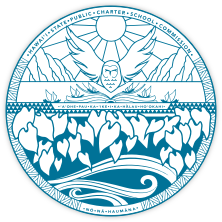The State Public Charter School Commission this week formally presented its annual report to the State Board of Education, the third annual report by the Commission since its creation in 2012 by Act 130. The report, which primarily provides information from the 2013-2014 school year, highlights both successes and ongoing challenges in Hawaii’s charter system.
Act 130 created the Commission with a principal focus on accountability-related authorizer functions, including the development and implementation of a rigorous accountability system that safeguards student and public interests while at the same time valuing the autonomy and flexibility of Hawaii’s public charter schools. As part of the new system, all of Hawaii’s 34 charter schools currently operate pursuant to a three-year charter contract under which the academic, financial, and organizational performance of each school is evaluated annually.
The report includes detailed information on every individual school’s results, as well as information about how the charter sector is performing as a whole and about the challenges the schools and the system face. “While it’s clear that much work remains to be done, overall Hawaii’s charter schools and its chartering system continue to show promising signs of improvement,” said Commission Executive Director Tom Hutton.
Among the highlights:
Academic
- As measured by the State’s Strive HI Performance System in 2013-2014, the charter schools’ collective results fell under the statewide averages on most indicators of academic performance.
- On the other hand, charter schools showed collective progress over 2012-2013 results on every Strive HI indicator except two.
- All five charter schools that had been classified in the bottom “Priority” tier under Strive HI in the previous year showed progress under Strive HI in 2013-2014, with one reclassified this year into the next highest “Focus” category.
- As measured by Strive HI, five of the state’s 11 top-performing public high schools—Myron B. Thompson Academy, Kula Aupuni Niihau A Kahelelani Aloha (KANAKA) A New Century Public Charter School (PCS), University Laboratory School, Hawaii Academy of Arts and Science (HAAS), and Halau Ku Mana Public Charter School—and two of its four top-performing public middle schools—Voyager: A Public Charter School and Innovations Public Charter School—were charter schools.
- This was the first year the Commission implemented its own Academic Performance Framework (APF), which evaluates charter schools differently than does Strive HI, including by placing heavier emphasis on proficiency and growth among high-needs students and by proportionally weighing the results for each grade level (elementary, middle, and high) for schools that serve more than one grade level.
- While it must be emphasized that these are only first-year results, under the APF, 21 schools either did not meet or fell far below the overall standard, 10 schools met the standard, and two schools—KANAKA and Ka ‘Umeke Kā‘eo—exceeded the standard.
Financial
- Financial data continue to show that charter schools generally are good stewards of public funding, a very important point in light of revelations of financial mismanagement at one school.
- While some financial indicators for charter schools collectively improved last year, the data signal longer-term sustainability challenges for charter schools if funding levels remain essentially flat and/or schools are not able to realize more cost savings.
Organizational
- This year the schools’ organizational capacities were measured primarily by whether they had some fairly basic policies and practices in place in five areas, a deliberately incremental approach that acknowledges that the schools were not asked for these things consistently under the previous law and that most are lightly staffed.
- Most schools fulfilled all or almost all of the 2013-2014 organizational measures.
- The organizational framework highlights the need for additional attention to certain issues, including the transparency of school governing boards and the securing of needed permits and certificates for charter school facilities on state lands.
“This report helps all of us take stock of where we are in implementing the vision of Act 130,” said Commission Chairperson Catherine Payne. “It’s been difficult, and we still have a long way to go, but the Commission remains committed to the hard work of ensuring that our charter schools are able to fulfill their missions and their responsibilities to the public and our keiki.”
The Commission also will deliver its annual report to the State Legislature. The report is available here.

